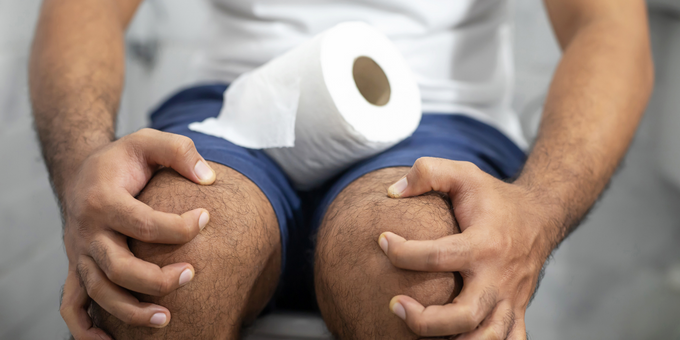You’re probably familiar with the struggle of needing to go to the toilet before you go out, but finding nothing’s moving. We know, being blocked up is the poos – pun intended. Here’s what you can do about it.
Constipation usually occurs because of a dehydrated colon – this means your stool will be loose and watery, and much harder to pass. This condition will affect most of us at some point in our lives, and considering 24% of Aussies are chronically afflicted, we decided to put together a comprehensive list of 5 simple things you can do to get things going again.
Load up on Fibre.
Dietary fibre is one of the most common pieces of advice you’ll find when seeking answers for your toilet troubles – and for good reason. It helps to soften your stool, along with increasing the size of it, which actually makes it easier to pass. With only 5% of us getting enough fibre, it’s worth upping your dose to see if your symptoms subside. 19 to 38 grams per day is the current daily intake recommendation – to put that into perspective, one cup of quinoa packs 5 grams of fibre – that’s nearly 25% of your needs – so it’s not that hard to get there.
Opt for the following foods:
- Whole fruits like pears, apples and oranges.
- Whole grains like quinoa, buckwheat and oats.
- Veggies like sweet potatoes and leafy greens.
- Legumes like lentils and chickpeas.
- Nuts and seeds.

Drink more water.
If you’ve been skimping on the aqua, this could be to blame for your constipation. After all, this digestive issue is related to a dry, dehydrated colon, and one important step to take is to check on your water intake. While that theory about getting 8 glasses a day hasn’t actually been proven, studies show drinking water when you’re thirsty is a more useful way to stay hydrated without overdoing it.
When your body is hydrated, less water will be taken from your colon, meaning easier loo trips. Another simple tip is to add some citrus fruits like lemon or lime to your water, this could help get your colon moving. For more successful results, make it warm water – studies have found that warmer water helps to break down food better and reduce constipation.
Get moving.
Exercise is another way to get your bowels moving again. It works by getting food to move through the intestine quicker, which then maximises the amount of moisture left in your stool when it comes time to go – which, of course, makes for a smoother experience.
For quicker relief, try the Wind-Relieving yoga exercise:
- Lie on your back.
- With your left leg extended in front of you, move your right knee to your chest.
- Hold it there with both arms while you take 10 to 20 breaths.
- Then release your right leg and fully extend it.
- Repeat these steps, but switch legs.

Exercise can also help relieve stress which can also cause constipation – as if the list of problems caused by stress wasn’t long enough already! One study found that doing some aerobics activities 2 days a week significantly reduced stress levels, so get those running shoes on.
Don’t hold it in.
Holding your poo in on rare occasions generally won’t have health consequences – so if you’re in the middle of a presentation, you don’t have to dash off to the bathroom before finishing your speech. But it can lead to adverse effects, like constipation, if you make a habit out of it. This is because holding it in for too long can result in the stool having moisture stripped from it and thus becoming harder to pass.
Try a laxative.
If the above aren’t working fast enough and you’re desperate to get things moving, there are a few options on the market, from bulk-forming laxatives to stool softeners. The latter, also known as emollient laxatives, help to soften the stool and are gentler than some of the other types. But they’re best used for milder, short-term cases. For more long-term use, bulk-forming laxatives can be a suitable option – though it’s best to check in with your doctor first. This laxative creates a gel in your stool to help it hold more water, which then helps to get things moving. Hyperosmotic laxatives work by bringing more water into your intestines, which then helps things soften and move through more easily.

But it’s also what you don’t do that matters. Eating sugar is a sure-fire way to exacerbate or even cause constipation. This is because those high-sugar foods usually are low in fibre. The result? Loose, watery and hard-to-pass stools. Some health bodies have even recommended avoiding sugary processed goods to reduce or prevent constipation.
If you’re having trouble kicking a sticky sugar habit, we’re here to help. Join us for our 8-Week Program where we’ll be ditching sugar and taking back control of our health. When you sign up to the program, you’ll have access to extensive plans, community support and exclusive access to our sugar-free content. Here’s what’s on offer:
- 8 weeks of expert-crafted meal plans and shopping lists.
- 90+ member-only recipes.
- Community forums to share your journey.
- Support from the I Quit Sugar team, plus our panel of experts.
- Mental and physical health benefits that last a lifetime.
If you’re ready to transform your health and say goodbye to sugar crashes, JOIN NOW!






Leave a comment (all fields required)